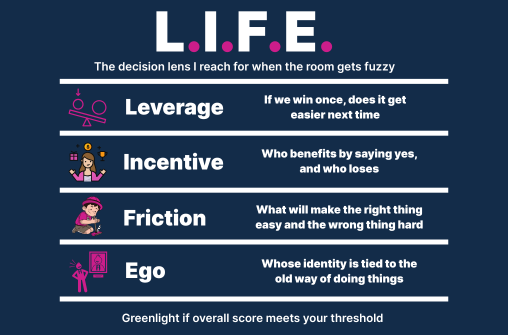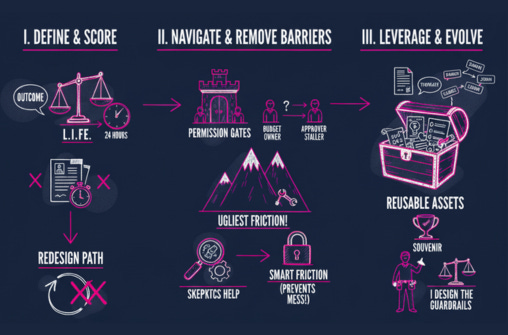FAVOR: If you enjoy our content, please follow along here on substack, as well as our Podcast, PossibLaw on the various platforms. We greatly appreciate it!
A few years back, I walked into a GC’s office with what I thought was a slam dunk demo. Shiny software, clean slides, the whole airport bookstore fantasy. She listened, nodded, then asked three questions that popped the balloon. Who signs the check, who keeps this alive when the champion leaves, and what do I say when a regulator asks why we trusted it.
That was the moment I admitted what I already knew. Good ideas often lose for boring reasons. I started naming those reasons out loud, Leverage, Incentive, Friction, Ego, and I used them like a flashlight instead of a fog machine. I call it L.I.F.E., and it is how I decide what to build, what to buy, and whether AI is actually ready for a legal setting that owns real risk, not just a demo reel.
The conversation I keep having
In law and tech, we love elegant logic, perfect memos, clever workflows, and AI that looks like it drinks green juice. Outcomes are not decided there. Outcomes are decided by distribution you do not control, budgets that do not align, integrations that pretend to be simple until Friday at 4 p.m., and status games that everyone denies while playing to win.
We tweak, we rarely transform, and then we hold a retro to celebrate the tweak.
So when someone asks, should we do this, I pull out L.I.F.E. and say, let’s score it like adults who have touched a budget before.
Leverage. If we win once, does it get easier next time. Do we build assets, data, templates, and precedent that compound. If a win cannot be reused, it is cardio, not strength training.
Incentive. Who benefits by saying yes, and who loses money, status, or control. Follow the budget lines, not the applause lines. Claps do not convert to purchase orders.
Friction. What will make the right thing easy and the wrong thing hard. Approvals, integrations, ownership, security reviews. Some friction keeps the car on the road, some friction keeps the car in the garage, learn the difference.
Ego. Whose identity is tied to the old way. How do we let them keep status while the process changes. If the current badge says I read every word, offer a new badge that says I design the guardrails.
If a path is not a four out of five on at least two factors, or fixable to get there, I do not greenlight it. This is not cynicism, this is survival and a healthy respect for shipping dates.
An exemplar moment that cemented it
The contract AI that almost wowed us into a trap
We were evaluating an AI summarizer. The demo had perfect lighting and a confident soundtrack. Then we ran L.I.F.E.
Leverage: no clean clause library, the model would hover at average like a ceiling fan.
Incentive: legal had headcount budget, not software budget, the math was allergic to the purchase.
Friction: SSO, data residency, and a DPIA, hello ninety day delay and three new calendar invites.
Ego: senior reviewers equated expertise with reading every word, highlighter ink was a lifestyle.
We didn’t say no, we said not yet. We built a clause taxonomy and a redline playbook, leverage started compounding. We worked with finance to reallocate budget, incentives clicked into place. We prewired security, friction dropped without removing the guardrails. We credited reviewers as authors on AI assisted outputs, ego stayed intact and focused on quality. When we revisited the vendor, the decision was easy, we had raised leverage, aligned incentives, tuned friction, and respected ego, so the tool finally had a real shot instead of a flashy audition.
How to actually run this with teams
Sit down with a whiteboard and say, work backward from the end state. Then move.
Define the outcome and score L.I.F.E. Try intake to first draft in 24 hours without more errors. Score each factor from one to five. If two factors are not at four or better, redesign the path, do not negotiate with gravity.
Expose the real economics and permission gates. Name the budget owner, name the approver, and name the person who can quietly stall it. Build a route where skeptics win by helping, and where the only way to block progress is to fix a real risk in daylight.
Remove the ugliest friction first. Pick data quality, or integration, or ownership, and fix it end to end. Do not pilot a maybe, deliver one irreversible improvement. Keep a little smart friction in place, the kind that prevents mess, not the kind that prevents motion.
Bank leverage as reusable assets. Turn each win into a template, a prompt kit, a clause library, or a run book. If it is not reusable, it is a souvenir.
Right size ego with status positive roles. Shift identity from I do every review to I design the guardrails. Put names on the artifacts, let credit travel faster than rumors.
Applying L.I.F.E. to AI without the hype hangover
Here is what I tell legal and tech leaders who want AI to help, not haunt.
Leverage: favor tools that learn from your data with your guardrails, build feedback loops before you build a slide about prompts.
Incentive: price to outcomes, cost per decision improved beats tokens per month, and let business units keep a slice of savings for adopting AI.
Friction: pre clear security, DPIA, and data lineage, publish a one page model card, make the safe path the fast path so people choose it without a speech.
Ego: stamp authorship, authored by Legal, accelerated by AI, track wins with names attached so expertise grows, not just throughput.
In 90 days, good looks like this: a 30 percent cycle time cut on one high volume workflow, 60 percent reuse of new templates or playbooks, 70 percent weekly adoption by target users, and an audit ready model card with an exception log. No press release required, just results that pay their own renewal.
Why I keep using this lens
Because it turns fuzzy debates into choices we can actually make, it respects human factors without letting them run the show, and it moves law and technology, AI included, from interesting to in production, which is where the value lives and the invoices do too.
One question to sit with, on your last important decision, which L.I.F.E. factor did you mis score, and what single move would raise that score by two points this month.




